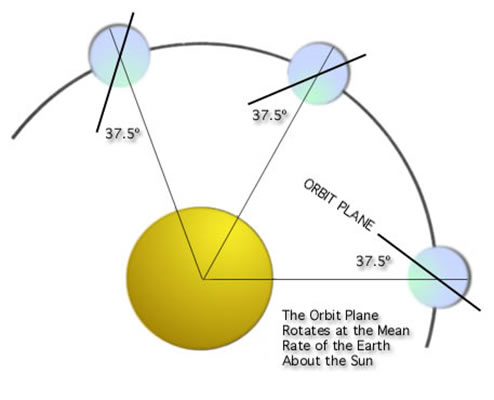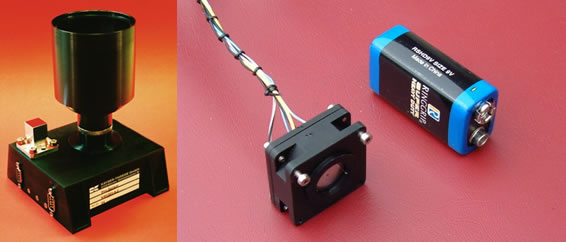The attitude determination and control system (ADACs) is responsible for measurement and control of the satellite attitude. This is particularly important for a space solar power system due to the need to maintain the orientation of the solar panels orthogonal to solar radiation and the need to accurately point the transmitting dish at the desired ground station. If the solar panels were to change attitude with respect to the Sun significantly, the amount of power collected would drop off rapidly. Maintenance of the attitude is a challenging issue for this system due to the sheer size of the solar panels and the resulting large aerodynamic forces and moments of inertia.
As mentioned on the orbital parameter page, the orbit was chosen to be sun synchronous in order to maintain the angle of the orbit with respect to the Sun, as shown below. With such an orbit, the solar panels would constantly point at the Sun if they were free of any perturbations.

Figure S1. Sun-synchronous orbit showing constant orientation with respect to Sun (from www.spaceyuga.com)
The primary perturbation torques on such a satellite are due to aerodynamic, gravitational, solar radiation, and magnetic forces. These forces are often unpredictable in nature, though relatively small in magnitude. Upper and lower bounds on the resulting torques may be calculated to find the maximum and minimum levels of torque that must be exerted by the attitude controllers.
Due to the fact that the torques are relatively small at any given time, but must be accounted for frequently to avoid significant change in attitude with respect with the Sun, a magnetoplasmadynamic (MPD) thruster system was chosen. Electrical and magnetic thruster systems are only capable of low thrust with respect to a chemical rocket, but they are much more mass efficient, with a specific impulse approximately ten times greater than that of a chemical rocket. Multiple MPD thrusters will be placed along the dark side of the solar panels, far from the center of mass of the satellite to maximize the moment arm and therefore the torque.
The second consideration for ADACs is the measurement of the attitude of the satellite. Multiple Sun sensors will be placed along the light-facing side of the solar panels, allowing the satellite to detect if the panels are orthogonal to the incoming solar radiation to within 0.01 degrees. A star tracker will be used to determine the absolute attitude of the main body of the satellite, allowing it to accurately point the transmitting dish at the ground station. This configuration was chosen as Sun sensors are relatively inexpensive as compared to star trackers, and provide the most relevant information necessary for the accurate pointing of the solar panels. The star tracker is necessary for the transmitter dish pointing, however, as there is no less expensive solution for the level of precision needed for the dish pointing (precision greater than two arc seconds).

